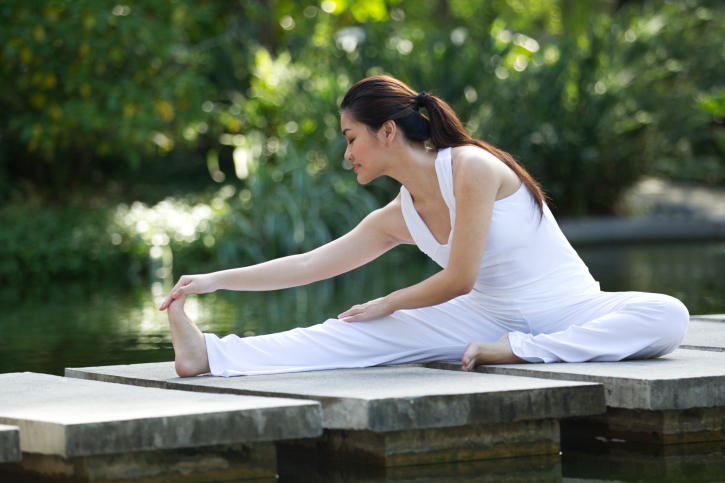Two new studies offer a glimmer of hope for sufferers of chronic low back pain, from an unexpected source-yoga. The ancient physical, mental and spiritual discipline, which originated in ancient India and came to America in the 1890s, outperformed self-care for back pain in both studies. While yogas stretching activities seemed to be the primary factor in patients improvement, one of the studies also cited its mental discipline as possibly helpful for back-pain sufferers.

Sixty to ninety percent of all adults experience back pain at some point in their lives, notes Miriam E. Nelson, PhD, director of Tufts John Hancock Research Center on Physical Activity, Nutrition and Obesity Prevention and author of Strong Women, Strong Backs. Its no wonder when you look at what our backs have to do-twist, lift, shove, heave, etc. Our backs are made up of a series of vertebrae, ligaments, tendons and nerves. The vertebrae come together at 20 small, intricate joints.
Yoga, Nelson adds, is a terrific exercise that reduces stress and increases both flexibility and coordination, improving your health and fitness.
Can it also alleviate back pain? Two studies, published within days of each other in Archives of Internal Medicine and Annals of Internal Medicine, set out to test that possibility. The first study compared weekly yoga classes to self-care or conventional stretching exercises among 228 sufferers of chronic low back pain. Both the yoga and the stretching activity improved function at 12 and 26 weeks.
At no point, however, was yoga superior to conventional stretching exercises. Lead author Karen Sherman, PhD, MPH, of Group Health Research Institute in Seattle, concluded, Physical activity involving stretching, regardless of whether it is achieved using yoga or more conventional exercises, has moderate benefits in individuals with moderately impairing low back pain.
We expected back pain to ease more with yoga than with stretching, so our findings surprised us, Sherman added. The most straightforward interpretation of our findings would be that yogas benefits on back function and symptoms were largely physical, due to the stretching and strengthening of muscles.
Both the yoga and stretching classes were 75 minutes long, but the stretching class spent more time-52 minutes-actually performing stretching exercises. The yoga class also spent time with breathing and deep relaxation exercises.
Sherman said, Its important to emphasize that both yoga and stretching had clinically important benefits.
In the second study, yoga also proved more effective than self-care, and researchers partly credited the disciplines focus on mindfulness. Helen Tilbrook, MSc, of the University of York, and colleagues randomly assigned 313 back-pain patients to yoga training or usual care with no active intervention. All participants received a back-pain educational booklet. The yoga group participated in 12 classes over a three-month span.
The yoga group reported superior back function at three, six and 12 months, as measured by a standard test of disability, along with greater confidence in performing normal activities. There was no difference between the yoga and control groups, however, in scores of back pain or general health.
| What Causes Back Pain? |
- In her book, Strong Women, Strong Backs, Tufts Miriam E. Nelson, PhD, lists some of the numerous causes of back pain:
- Lack of strength and flexibility
- Excess body weight
- Poor posture
- Degenerative disks
- Scoliosis
- Osteoporosis
- Trauma
- Herniated disc
- Arthritis
- Spinal stenosis
Tilbrook and colleagues suggested that some of yogas apparent benefits could be due to its mental discipline, as well as its focus on posture. They noted, though, that those benefits diminished over time, after the yoga classes were completed; continuing classes may be needed to keep enjoying yogas functional benefits.
Yoga seems to be a safe and effective activity that clinicians could consider recommending for patients with a history of low back pain, the researchers concluded.
Not all yoga activities are equally beneficial, Tufts Nelson cautions. If youre looking for a strengthening benefit, she says, you can tell by how your muscles feel whether its effective. If the pose is challenging enough so that you can hold it only for a minute before you need to rest, and if you feel the burn of muscle fatigue, then probably youre getting some strengthening effect.
If you have osteoporosis and are tempted to try yoga, Nelson adds, keep in mind that forward flexation can be dangerous to your spine. Before you tackle any new fitness regimen, its smart to check with your healthcare professional.
TO LEARN MORE: Archives of Internal Medicine, online first; abstract at archinte.ama-assn.org/cgi/content/short/archinternmed.2011.524. Annals of Internal Medicine, Nov. 1, 2011; abstract at www.annals.org/content/155/9/569.abstract?aimhp.
























